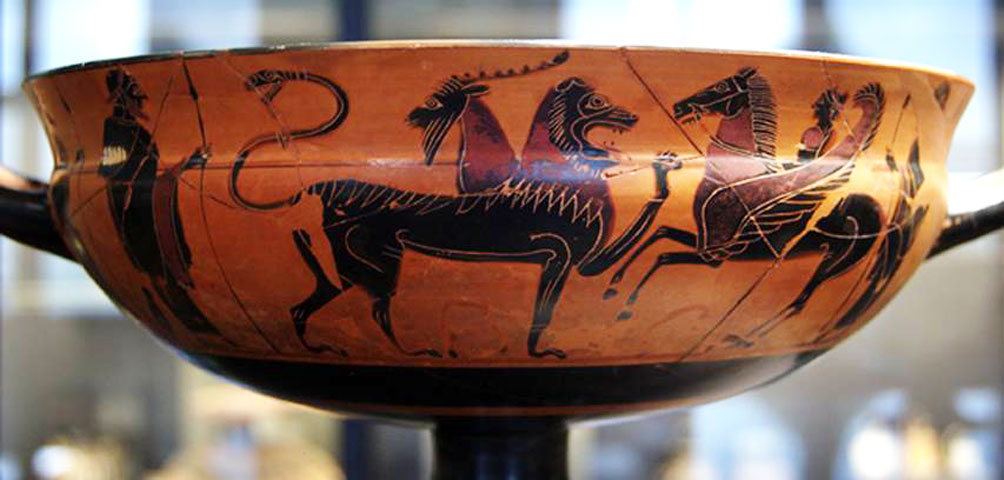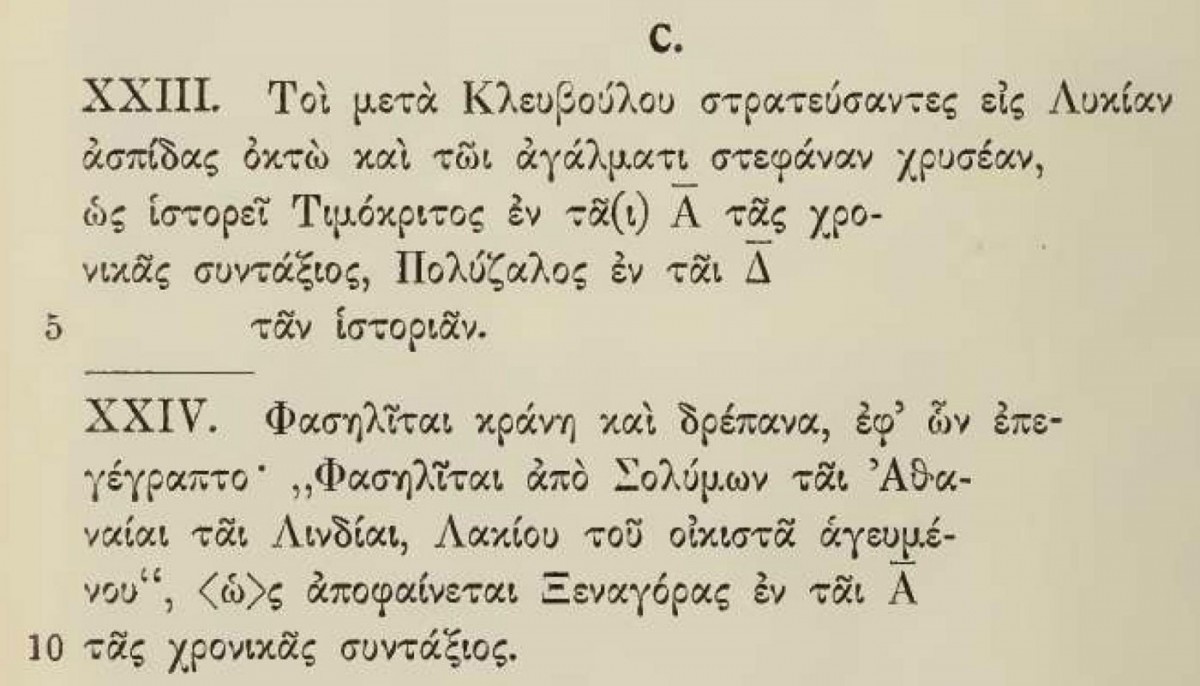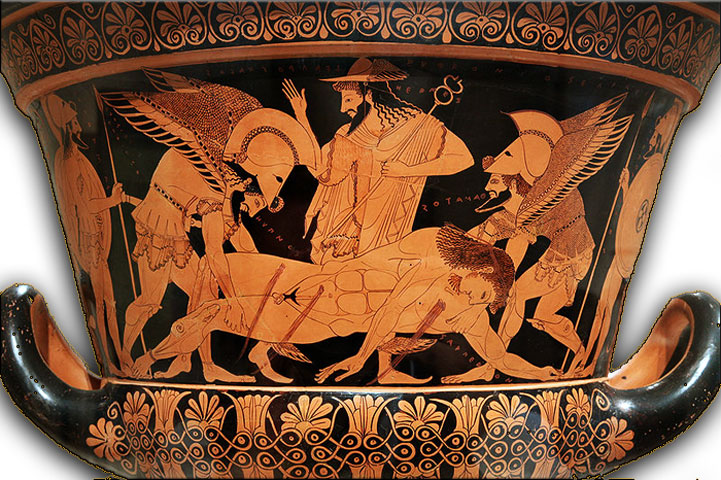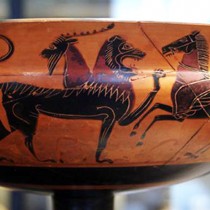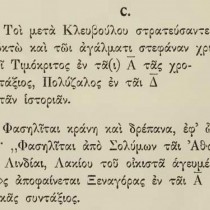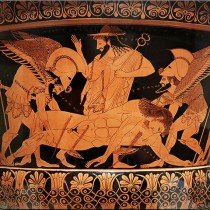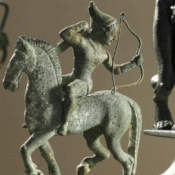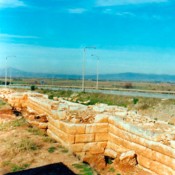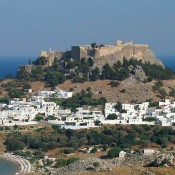Lycia, a country associated with legends and traditions already since Homeric times, extends along the south east coast of Asia Minor, east of Rhodes and very close to it. We first encounter the Lycians in the “Iliad”, on the side of the Trojans. Their leaders were Glaucus and Sarpedon. According to myth, the latter was brother to Minos who had been banished from Crete to Lycia. The Lycians were also supposed to have built the Cyclopean Walls at Mycenae and Tiryns in Argolis, while, according to myth, it was believed that the Cyclops had come from Lycia (note 1). The Lycians are also linked to the myth of Bellerοphon whose name was given to the separate municipality (δήμος) of Xanthou, where his tomb is also situated. Specifically, it is thought that the myth of Bellerophon was transferred from Lycia to both Mycenean Argolis and Corinth, without however being associated with Pegasus (note 2).
Lycia was always connected with Greece and its world and was examined by scholars as an integral part of it. According to bibliographic sources, the specific region was presented as a peculiar “contact zone”, a sphere of interaction and a link between two cultures, those of the Greeks and the peoples of the Near East. We learn about this process of interaction between the above, both from references to Lycians found in Greek and Roman authors (note 3) and from other sources. Among other things, ancient commentators remark about traces of an old enmity between Rhodians and Lycians on account of the duel of Sarpedon and Tlepolemus. The Lycian resistance against the Greeks was helped by the difficult access the latter had to the formers’ country, as it was closed from the sea and surrounded by steep cliffs. For a long time the Greeks could not infiltrate the heart of the country, which is why Lycian tribes continued to live on their land, in accordance with their ancient customs. Herodotus confirms the antiquity of these tribes which preserved a conservative way of life through time and he notes the survival of a matriarchal model in the Lycians’ social organization.
As we mentioned above, the first reference to Lycians in ancient Greek letters is found in Homer’s “Iliad”. The Lycians’ expeditionary force appeared as the strongest among the allies and was assembled to aid the besieged Trojans (note 4). There is an interesting excerpt in the Homeric epic that refers to the episode of the duel between Sarpedon king of Lycia and Tlepolemus son of Hercules (note 5) and leader of the Dorian settlers in Rhodes (note 6). According to Homer in the “Iliad” (note 7) as well as other written sources available to us, the colonization of Rhodes by the Dorians was realized under the leadership of Tlepolemus, with the three Dorian tribes arriving on the island being united politically and as a military force under the guidance of this worthy leader. There is no information on conflict with local populations. Strong remains of Mycenaean Rhodes were quickly transferred to the Dorians’ geometric art (note 8).
Homer also writes (note 9): “…but Tlepolemus, son of Heracles, a valiant man and tall, was roused by resistless fate against godlike Sarpedon. And when they were come near as they advanced one against the other, the son and grandson of Zeus the cloud gatherer, then Tlepolemus was first to speak, saying: ‘Sarpedon, councellor of the Lycians, why must thou be skulking here, that are a man unskilled in battle? They speak but a lie that say thou art sprung from Zeus that beareth the aegis, seeing thou art inferior far to those warriors that were sprung from Zeus in the days of men of old. Of other sort, men say, was mighty Heracles, my father, staunch in fight, the lionhearted, who on a time came hither by reason of the mares of Laomedon with but six ships and a scantier host, yet sacked the city of Ilios and made waste her streets.But thine is a coward’s heart and thy people are minishing. In no wise methinks shall thy coming from Lycia prove a defence to the men of Troy, though thou be never so strong, but thou shalt be vanquished by my hand and pass the gates of Hades’… And Tlepolemus lifted on high his ashen spear and the long spears sped from the hands of both at one moment. Sarpedon smote him full upon the neck and the grievous point passed clean through and down upon his eyes came the darkness of night and enfolded him. And Tlepolemus smote Sarpedon upon the left thigh with his long spear and the point sped through furiously and grazed the bone; howbeit his father as yet warded from him destruction….But not for great-hearted Odysseus was it ordained to slay with the sharp bronze the valiant son of Zeus. Whereby Athene turned his mind toward the host of the Lycians.”
The duel episode has a strong emotional quality. The words of the son of Heracles are full of mockery, distain and insults and it is obvious he seeks to destroy his opponent. Tlepolemus is the first to speak and says:
“Sarpedon, councellor of the Lycians, why must thou be skulking here, that are a man unskilled in battle? They speak but a lie that say thou art sprung from Zeus that beareth the aegis, seeing thou art inferior far to those warriors that were sprung from Zeus in the days of men of old. Of other sort, men say, was mighty Heracles, my father, staunch in fight, the lionhearted, who on a time came hither by reason of the mares of Laomedon with but six ships and a scantier host, yet sacked the city of Ilios and made waste her streets.But thine is a coward’s heart and thy people are minishing. In no wise methinks shall thy coming from Lycia prove a defence to the men of Troy.”
(«Σαρπῆδον Λυκίων βουληφόρε, τίς τοι ἀνάγκη / πτώσσειν ἐνθάδ᾿ ἐόντι μάχης ἀδαήμονι φωτί;
ψευδόμενοι δέ σέ φασι Διὸς γόνον αἰγιόχοιο / εἶναι, ἐπεὶ πολλὸν κείνων ἐπιδεύεαι ἀνδρῶν / οἳ Διὸς ἐξεγένοντο ἐπὶ προτέρων ἀνθρώπων: / ἀλλ᾿ οἷόν τινά φασι βίην Ἡρακληείην / εἶναι, ἐμὸν πατέρα θρασυμέμνονα θυμολέοντα:
ὅς ποτε δεῦρ᾿ ἐλθὼν ἕνεχ᾿ ἵππων Λαομέδοντος / ἓξ οἴῃς σὺν νηυσὶ καὶ ἀνδράσι παυροτέροισιν / Ἰλίου ἐξαλάπαξε πόλιν, χήρωσε δ᾿ ἀγυιάς: / σοὶ δὲ κακὸς μὲν θυμός, ἀποφθινύθουσι δὲ λαοί. / οὐδέ τί σε Τρώεσσιν ὀΐομαι ἄλκαρ ἔσεσθαι».) (note 10)
As we know, elements of real history appear in works of literature. In the process of analyzing the above extract from the Iliad, many questions arise related to the feeling of justice (note 11).
And Homer continues: “… and the long spears sped from the hands of both at one moment. Sarpedon smote him full upon the neck and the grievous point passed clean through and down upon his eyes came the darkness of night and enfolded him. And Tlepolemus smote Sarpedon upon the left thigh with his long spear.” («…καὶ τῶν μέν ἁμαρτῇ δούρατα μακρὰ / ἐκ χειρῶν ἤϊξαν·ὃ μὲν βάλεν αὐχένα μέσσον / Σαρπηδών, αἰχμὴ δὲ διαμπερές ἦλθ’ ἀλεγεινή, τὸν δὲ κατ’ ὀφθαλμῶν ἐρεβεννὴ νὺξ ἐκάλυψεν / Τληπόλεμος δ’ ἄρα μηρὸν ἀριστερὸν ἔγχει μακρῷ / βεβλήκειν».) (note 12)
How, does the poet, however, present the theme of the duel and ultimately the heroes’ mutual destruction in the Iliad epic? The fifth rhapsody describes the encounter, dialogue and finally the duel with the simultaneous blow dealt by Sarpedon and Tlepolemus causing the death of the latter and serious consequences for the former, resulting from his serious wound and his withdrawal from the battle. The outcome of the duel is obvious in the Iliad because convention dictates that one prevail entirely over the other and perhaps a slight wounding of the victor. In his epic, Homer does not kill Sarpedon with Tlepolemos’ first blow. In the poet’s eyes, Sarpedon is the hero most suited to challenge Patroclus. He, Sarpedon, had to survive in order to be killed much later in rhapsody XVI (Π) by Patroclus. Tlepolemus invokes the name of his ancestor Heracles, the reason being the conquest of impregnable Troy. The insult and distain in Tlepolemus’ speech to Sarpedon had much in common with the dialogue between Agamemnon and Diomedes. In the Theban tradition, the simultaneous death of heroes/dualists was a usual act in the drama. It is worth mentioning the brothers Tydeas and Melanippos’ destruction of one another which caused their race to be wiped out (note 13). Thus we move from the literary tradition of Thebes to the Iliad.
At a first glance, the Sarpedon-Tlepolemus episode seems insignificant. Special attention should be given to it however, since information is poor in all other sources regarding the state of affairs prevailing in south west Asia Minor at that particular time. Works throwing light directly on the history of Lycia were mostly written by people born in Asia Minor, such as Alexander Polyhistor, Menecrates of Xanthus (note 14), of whose writings only fragments survive. The body of inscriptions in Lycian script A and B is restricted in breadth and variety. These are mainly burial inscriptions. Based on epigraphy data, their analysis and interpretation becomes even more complicated due to Lycian languages being studied at different levels (note 15). Epigraphy material which includes Greek inscriptions from Lycia is mentioned at a later date (note 16). Likewise, archaeological data is scarce because in specific regions archaeological surveys had not been realized and completed on a broad scale, while even in places such as e.g. Xanthos, Limyra and Tlos where excavations have been carried out, surveys and studies had obviously not been made in all the layers (note 17).
Analysis both of extracts from the Iliad and a considerable part of information on the Lycians learned from Greek authors takes on an epic mythological character in the way it is approached. Religious and mythological plots also appear in reliable historical sources, because religion, on the one hand, had from its beginnings a spiritual, moral and ideological grounding in the life of ancient societies, while also directly influencing social relations. Various political events such as conflicts with the Rhodians, as well as social phenomena such as the matriarchal structure of family were refracted through the prism of mythological symbols and reflected in the epic of the Iliad (note 18).
The clash between Sarpedon and Tlepolemus has often interested scholars when analyzing the Homeric epics. In the episode narrating the duel between the son and grandson of Zeus, all scholars alike discerned the epic mythological dimension of the conflict between Lycians and Rhodians, supposedly taking place in the Mycenaean era (note 19). Nevertheless, most authors restricted themselves to confirming the event without analyzing the causes of the conflict.
During the 9th, 8th, 7th and perhaps part of the 6th century BC, the Rhodians fought against the Lycians, trying to gain access to the coast of Lycia, so as to infiltrate its fertile and rich valleys, make use of its forests’ abundant timber as raw material for their shipbuilding industry (note 20).
When examining the issue of the Lycians’ conflicts with Rhodes, it is essential to focus our attention on the observation of the commentator “They say that the Lycians were always enemies of the Rhodians” (note 21). It is clear that the enmity between the Lycians and settlers from Rhodes had its roots in their trading relations. Trade played an important part in the island’s economy and the matter of trade routes security was vital in achieving economic goals. Already in letters from the diplomatic archive of Tel El Amarna, associated with the 14th c. BC, mention is made of the pirate races of the Lukka (note 22).
The Lukka attacks on the “country of the Pharaohs” the first half of the 14th c. BC, was the cause for the peculiar “continuation” of their seasonal raids on Alasia in Cyprus (note 23).
The Egyptian Pharaoh Amenhotep III was always preoccupied with the protection of the Delta coast from raids by the Lukka. In modern historiography the Lycians are considered to be an eastern nation, speaking an Indo-European language which was closely connected to that of the Luwians and Hittites (note 24). Data analysis of Hittite and Egyptian sources from the end of the Late Bronze Age, often lead scholars to identify the early Lycians with the Lukka races (note 25). The periodic raids have led us to believe that there were permanent or seasonal bases on the south coast of Asia Minor or Cyprus. “Marauding groups of Lycian pirates invaded the shores of the eastern Mediterranean, they brazenly disembarked in the harbours of Cyprus, plundering the locals dwelling on its coast as well as those of Egypt and the Nile Delta” (note 26). T. Bryce justly doubts the type of information supplied in these letters, on the issue of tracing the Lukkas’ origins to the 14th c. BC. Nevertheless, the particular document is a testimony to their activities (note 27). Conflicts escalated at the time of Pharaoh Merneptah’s reign in the last quarter of the 12th c. BC. “No country stayed far from conflicts and waves of fire reached the courtyards of the Egyptians’ houses” (note 28).
“Sea peoples” was the term used by Egyptians for races of a different origin but with a particular ethnic placement. The Lukka were placed with great certainty among these races (note 29). Their inclusion in this group of “sea peoples” allows for the hypothesis that they were a maritime presence during the 12th c. BC. There was no reference to these peoples in Egyptian sources, following the reign of Merneptah after 1220 BC (note 30).
The reasons for their “disappearance” from the sources of historiography may be the change of their name, their resettlement or the incorporation of their ethnic group in some other.
A somewhat later source, namely extracts from the treatise of Heraclides of Pontus (387-312 BC) contains important information about ancient Lycia. We read in an extract on the Lycians: “The Lycians live off piracy. They do not live by the law and they have always been governed by women” (note 31). This extract, according to O. Treuber, is a reliable testimony on the war of the Lycians against the Rhodian trading ships (note 32). Unfortunately, no similar subject matter was found in other sources. Moreover, Strabo considers the Lycians as being a noble people with a leading position in culture, unlike their neighbours, the inhabitants of Pamphylia, who used their harbours as auxiliary stations for raids: “…but is exceedingly well supplied with harbors and inhabited by decent people. Indeed, the nature of the country, at least, is similar to both that of the Pamphylians and the Tracheian Cilicians, but the former used their places as bases of operation for the business of piracy, when they engaged in piracy themselves or offered them to pirates as markets for the sale of booty and as naval stations. In Side, at any rate, a city in Pamphylia, the dockyards stood open to the Cilicians, who would sell their captives at auction there, though admitting that these were freemen. But the Lycians continued living in such a civilized and decent way that, although the Pamphylians through their successes gained the mastery of the sea as far as Italy, still they themselves were stirred by no desire for shameful gain, but remained within the ancestral domain of the Lycian League.” (note 33)
(«…αλλ’ ευλίμενος σφόδρα και υπό ανθρώπων συνοικούμενος σωφρόνων / επεί ή γε της χώρας φύσις παραπλησία και τοις Παμφύλοις εστί / και τοις Τραχειώταις Κίλιξιν, αλλ’ εκείνοι μεν ορμητηρίοις εχρήσαντο / τοις τόποις προς τα ληστήρια, αυτοί πειρατεύοντες ή τοις πειραταίς / λαφυροπώλια και ναύσταθμοι παρέχοντες. / Εν Σίδη γουν πόλει της Παμφυλίας τα ναυπήγια συνίστατο τοις Κίλιξιν, / υπό κήρυκά τε επώλουν εκεί τους αλόντας ελευθέρους ομολογούντες.
Λύκιοι δ’ ούτω πολιτικώς και σωφρόνως ζώντες / διετέλεσαν ώστ’ εκείνων δια τας ευτυχίας θαλαττοκρατησάντων / μέχρι της Ιταλίας όμως υπ’ ουδενός εξήρθησαν αισχρού κέρδους, / αλλ’ έμειναν εν τη πατρίω διοικήσει του Λυκιακού συστήματος.»)
We must, however, accept that the information given by our great geographer is, it seems, associated with a later stage in the history of Lycia, most probably the period of the Lycian League.
“There are twenty-three cities that share in the vote. They come together from each city to a general congress, after choosing whatever city they approve of…” («Εισί δε τρεις και είκοσι πόλεις αι της ψήφου μετέχουσαι, / συνέρχονται δε εξ εκάστης πόλεως εις κοινόν συνέδριον, / ήν αν δοκιμάσωσι πόλιν ελόμενοι...») (note 34)
Obviously, O. Treubner believes that Heraclides’ treatise is based on information from a Rhodian source (note 35).
Wecangetinformation on the history of Lycia mainly from the Rhodians who are geographically situated closer to it, but are clearly its enemies. Another factor also contributed to the increase of tension between these two peoples, with clashes that had already been evolving since the 9th and 8th c. BC. The Lycians were opposed to Greek colonization of Asia Minor (note 36). During that period the north east coast of Asia Minor was covered with a network of Greek cities, while the region of Lycia remained independent between the 8th and 7th c. BC and was not conquered through this process. The Rhodians made drastic attempts to prevail in commerce on the south west coast of Asia Minor, so as not only to infiltrate the fertile plains of Lycia but also to promote their trading interests. One such bright example was Phaselis, the Rhodians’ only colony, founded in the 7th c. BC. Blinkenberg dates the founding of Phaselis to 690 BC believing that the Rhodians are associated with the dedication of the Phaselites during the city’s establishment or shortly after.
The colonization of Lycia by the Greeks and mainly by Rhodes was not carried out in a peaceful manner. The bilingual inscriptions in Lycian and Greek testify to this, as well as the Chronicle of the temple of the Lindians. “This relationship also shows in fish sacrifices that took place annually in Phaselis and also in the water oracle at Klaros. At the same time, the custom of the citizens of Phaselis, as also mentioned in bibliography, is linked to the oracles in Lycia and the fish sacrifices and found in Athenaeus in his extract on Polycharmus. Moreover, the Lycian oracle at Surah was associated with the cult of Apollo” (note 37). Ichthyomancy was also an ancient art of divination, widespread mainly at Surah in Lycia, according to which, by examining the movements of fish, some future events were predicted.
Another more probable version is expressed here: “The land of Phaselis was conquered by Rhodian colonists, with the hostility of the locals a given fact” (note 38). In the region of Lycia ,specifically on the borders with Pamphylia and very close to it , was a very fertile plain.
Phaselis is established very close to this, on a small peninsular located at the foot of mount Tahtali Dagi and initially it had one harbor and already three, by Strabo’s times
The Lycians were also called Solymoi. Obviously the founding of Phaselis is associated primarily with trading objectives. In the history of Rhode’s trading relations in the Archaic period, Phaselis played an important role in the island’s power at a strategic level at the crossroads of trade routes. The three ports of Phaselis served as intermittent stops for ships heading from Rhodes to Cilicia and Lebanon (note 39). Thefoundingofcoloniesis encountered in the Chronicle of the Temple of the Lindians. This Chronicle, the work of the Rhodian Timachidas, is found today in Denmark in the “Ny Carlsberg Glyptotek”, a private museum in Copenhagen. In its first edition, Blinkenberg rightly pointed out that the Lycians are only presented as having been vanquished by the enemy, despite the fact that literary tradition refers to the purchase of Phaselite land by the Rhodians.
Phaselite etiquette can be understood by this example of the annual offering of the settlers to the locals. Likewise, one phrase from the Chronicle mentions «τοι μετά Κλευβούλου στρατεύσαντες εις Λυκίαν ασπίδας οκτώ και τωι αγάλματι στεφάναν χρυσέαν, ως ιστορεί Τιμόκριτος εν ται α τας χρονικάς συντάξιος, Πολύζαλος εν ται δ ταν ιστοριάν» (5, XXIII)” (note 40).
This is the only piece of evidence of the campaign of Kleovoulos tyrant of Lindos to Lycia with references by a 3rd or 2nd c. BC historian called Timokritus and the Rhodian historian Polyzalos from Ialysus. Also mentioned is a tribute by the Phaselites with an offering of a helmet and a curved sword on which were written: «Φασηλίται κράνη και δρέπανα, εφ ων επεγέγραπτο· Φασηλίται από Σολύμων ται Αθαναίαι ται Λινδίαι, Λακίου του οικιστά αγευμένου, ως αποφαίνεται Ξεναγόρας εν ται α τας χρονικάς συντάξιος» (6, XXIV), with reference to the Rhodian historian Xenagoras from the end of the 4th c. BC (note 41). According to all sources, the founding of Phaselis played an important part in trade and protected the ships from pirates who, in the past and till the colony’s founding, had been enemies of the Rhodians.
Epilogue
In closing this study we can draw the following conclusions: The conflict between Rhodians and Lycians, which had taken place in Mycenaean times, is reflected in an epic mythological manner in Homer’s Iliad and specifically in the episode of the Sarpedon-Tlepolemus duel. The specific conflict can obviously be explained, on the one hand, by the pirate raids of the Lycians and on the other by the Rhodians’ efforts to prevail militarily and consequently as traders on the south east coast of Asia Minor.
Konstantinos N. Thodis
Author-Historical researcher
